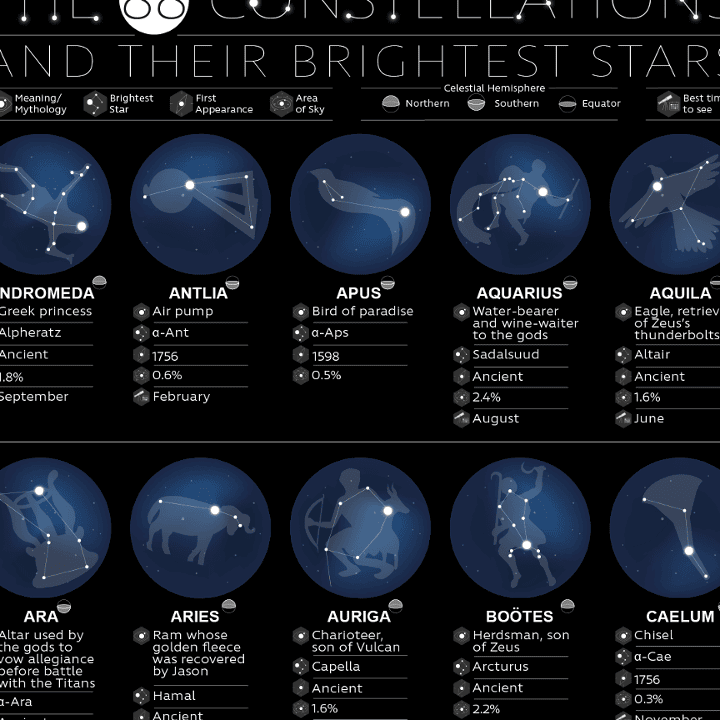
Currently, there are additional cumulative discounts (ranging from 2% to 25%) available for 58,757 educational establishments. To determine the discount applicable to all staff members of your educational institution, please log in to your personal Infoworks account.


Enhancing Professional Skills
Exploring media literacy as a method of engaging with modern parents
We can apply a discount from your educational institution to this offer (the amount will depend on the number of your colleagues who have completed the Infoworks course).
Currently, 58,757 educational institutions are offering additional discounts ranging from 2% to 25%. To determine the specific discount applicable to all employees of your educational institution, please log in to your personal Infoworks account.


Enrich your professional skills
Important aspects of career guidance work for teachers
We can apply a special discount to your educational institution in addition to the regular discount (the amount depends on the number of your colleagues who have completed Infoworks courses).
Currently, 58,757 educational institutions provide additional discounts ranging from 2% to 25%. To discover the specific discount available for all employees of your educational institution, please log in to your personal Infoworks account.


Guidelines for Dealing with Anxiety
Breakdown of the Presentation by Slide:

Slide 1: The sky is filled with numerous constellations that have captivated humans for centuries. These celestial formations are not only beautiful but also hold great cultural and scientific significance. In this presentation, we will explore the 10 most famous constellations in the sky.
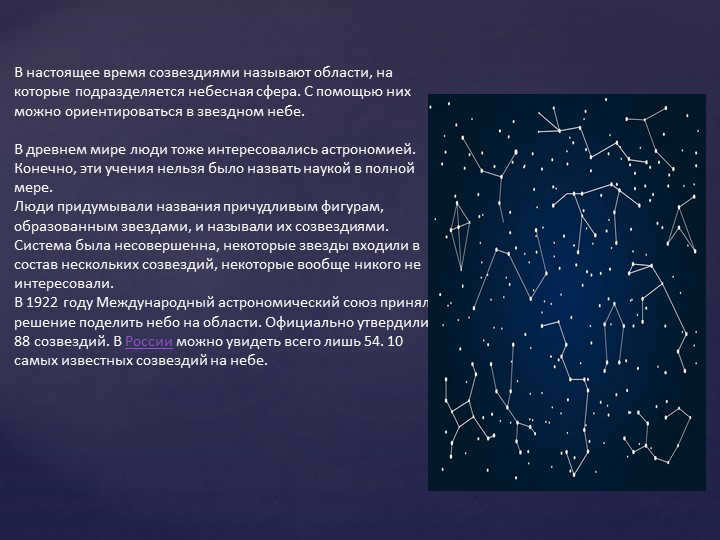

2 slide Currently, constellations are regions in the celestial sphere that are divided. They serve as a guide for navigating the starry sky.
In ancient times, people also had an interest in astronomy. However, these teachings were not considered a complete science. Individuals created names for the imaginative shapes formed by the stars and called them constellations. The system was not perfect, as some stars were part of multiple constellations while others were of little interest.
In 1922, the International Astronomical Union made the decision to divide the sky into specific regions. A total of 88 constellations were officially approved, with only 54 visible in Russia. Here are the top 10 most well-known constellations in the sky.
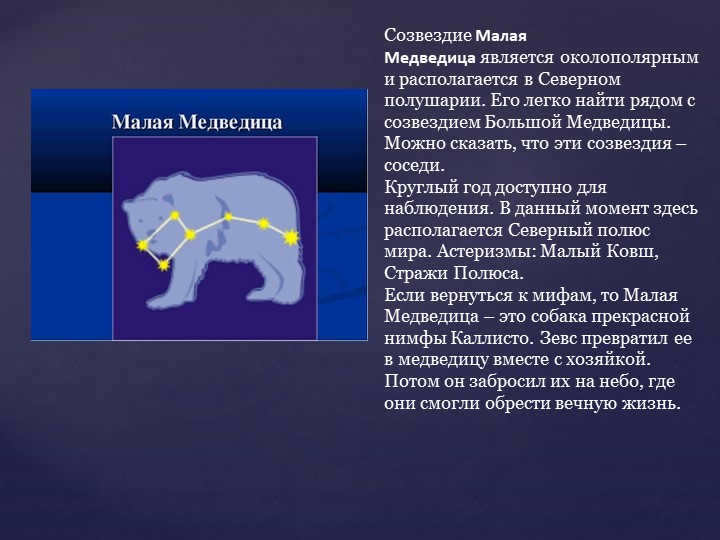

Slide 3: The Little Bear constellation is a nearby polar constellation found in the Northern Hemisphere. It can be easily spotted adjacent to the Big Dipper constellation, making them neighboring constellations. It is observable throughout the year, as the North Pole of the world is currently located here. Notable asterisms within this constellation include the Small Bucket and the Guardians of the Pole.
If we delve into mythology, the Little Bear represents the dog of the beautiful nymph Callisto. Zeus transformed both Callisto and her faithful companion into bears and placed them in the sky, granting them eternal life.
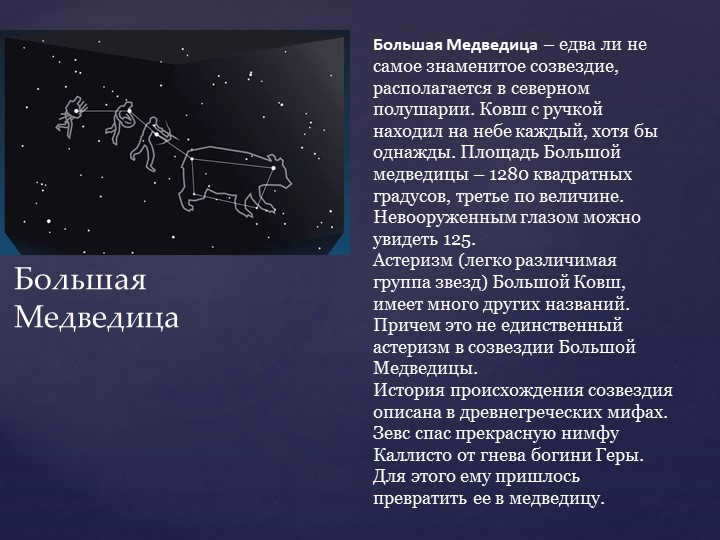

Slide 4 Big Dipper
The Big Dipper is not exactly the most well-known constellation, situated in the northern hemisphere. Everyone has spotted the ladle with a handle in the sky at least once. The extent of the Big Dipper – 1280 square degrees, the third largest. It can be observed with the naked eye.
Asterism (a distinct group of stars) the Big Dipper, goes by many other names. Additionally, this is not the sole asterism in the constellation of the Big Dipper.
The origins of the constellation are described in ancient Greek myths. Zeus rescued the beautiful nymph Callisto from the wrath of the goddess Hera. As a result, he had to transform her into a bear.

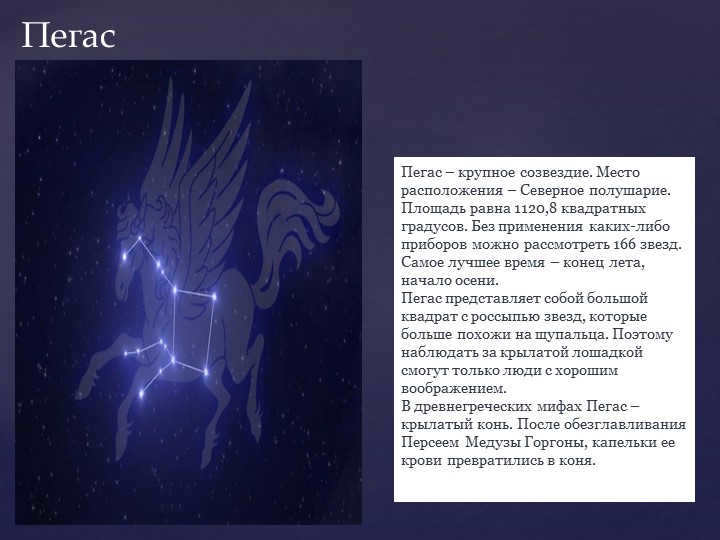
Slide 6 Pegasus
Pegasus, a vast constellation, is situated in the Northern Hemisphere. It spans an impressive area of 1120.8 square degrees and boasts a remarkable count of 166 stars visible to the naked eye. Late summer and early fall are the ideal seasons for observing this constellation.
Pegasus resembles a large square adorned with stars that resemble sprawling tentacles. Consequently, only individuals with vivid imaginations can truly appreciate the sight of this mythical winged horse.
In ancient Greek mythology, Pegasus was a magnificent winged horse. According to the legends, Pegasus came into existence when Perseus beheaded the Gorgon Medusa, and her blood transformed into this majestic creature.
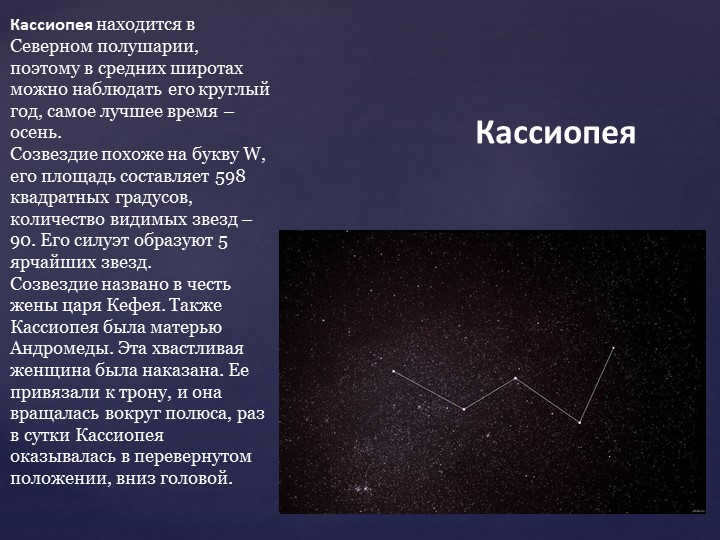
The constellation Cassiopeia is situated in the Northern Hemisphere, making it visible in the middle latitudes throughout the year, with the optimal viewing time being in the autumn season.
Resembling the letter W, Cassiopeia covers an area of 598 square degrees and contains a total of 90 visible stars. Its distinct shape is formed by the five brightest stars within the constellation.
This constellation is named after the wife of King Cepheus, Cassiopeia, who was also the mother of Andromeda. Cassiopeia, known for her arrogance, was punished by being tied to a throne and spun around a pole. As a result, she would find herself upside down once a day.
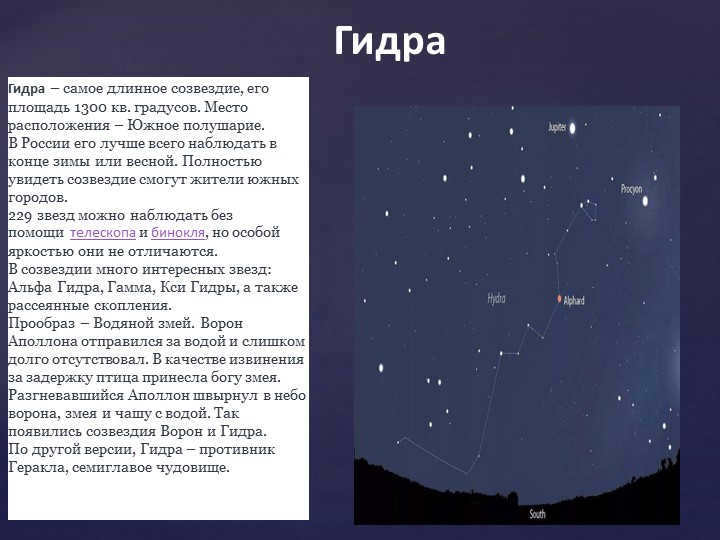
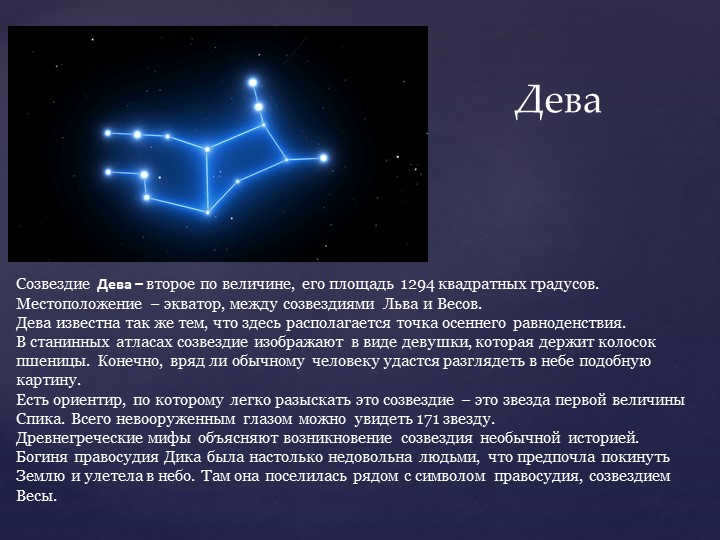
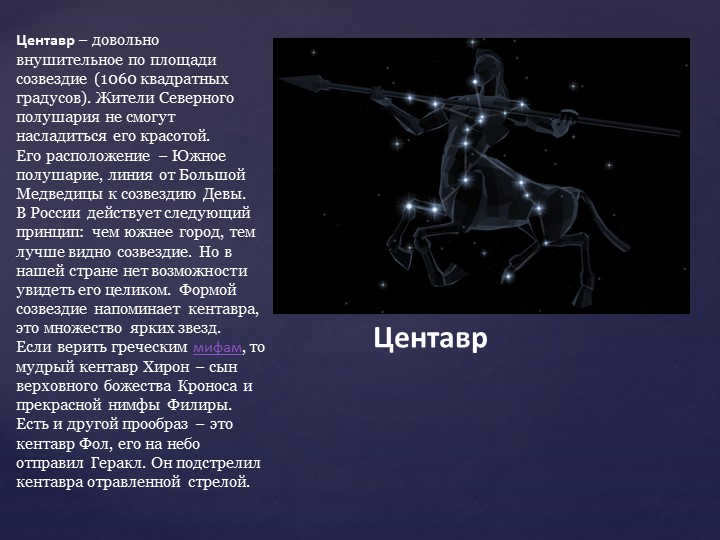
Centaurus is a constellation that covers a rather impressive area of 1,060 square degrees. Unfortunately, residents of the Northern Hemisphere won’t be able to admire its beauty.
The constellation is located in the Southern Hemisphere, along the line from the Big Dipper to the constellation Virgo. In Russia, the general rule is that the further south a city is, the better view of the constellation it offers. However, in our country, there is no opportunity to see Centaurus in its entirety.
The shape of Centaurus resembles a centaur and it is composed of numerous bright stars. According to Greek mythology, the wise centaur Chiron is believed to be the son of the supreme deity Kronos and the beautiful nymph Phyllis.
Another prototype of a centaur in Greek mythology is Phol, who was sent to heaven by Hercules. He shot the centaur with a poisoned arrow.
Centaurus is truly a remarkable constellation that is unfortunately out of reach for those in the Northern Hemisphere.
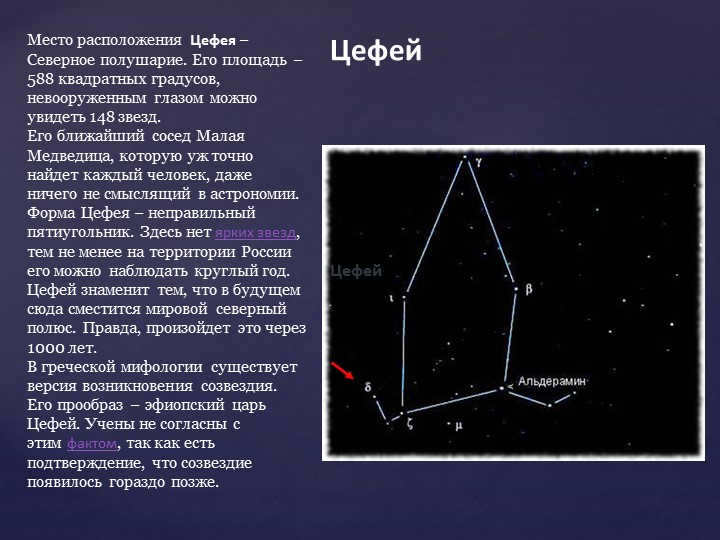
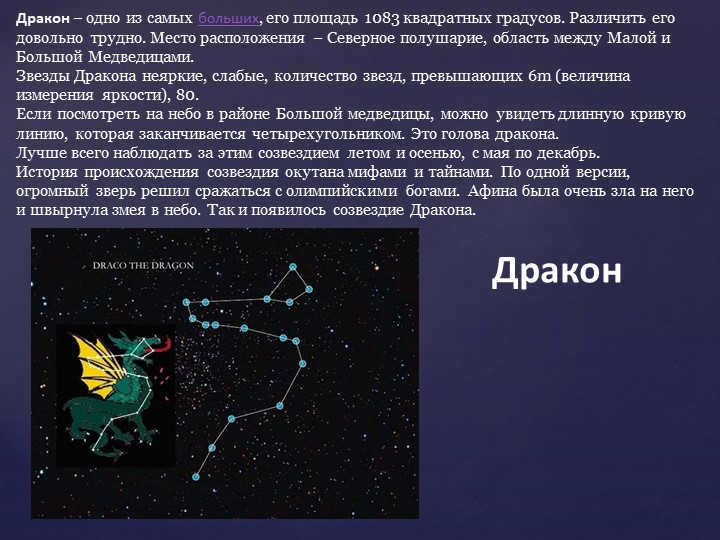
Slide 12: The Dragon is one of the largest constellations, covering an area of 1,083 square degrees. It can be quite challenging to distinguish it from other constellations. Located in the Northern Hemisphere, the Dragon lies between the Little Dipper and the Big Dipper.
The stars that make up the Dragon constellation are faint and dim, with a total of 80 stars exceeding a magnitude of 6m (a measurement of brightness).
If you gaze at the night sky near the Big Dipper, you’ll notice a long, curved line that culminates in a quadrangle shape. This represents the head of the Dragon.
The best time to observe this constellation is during the summer and fall, specifically from May to December.
The history and origins of the Dragon constellation are steeped in myths and mysteries. According to one version, a colossal beast dared to challenge the Olympian gods, angering Athena in the process. In response, she cast the serpent into the heavens, giving birth to the Dragon constellation.
Dragon
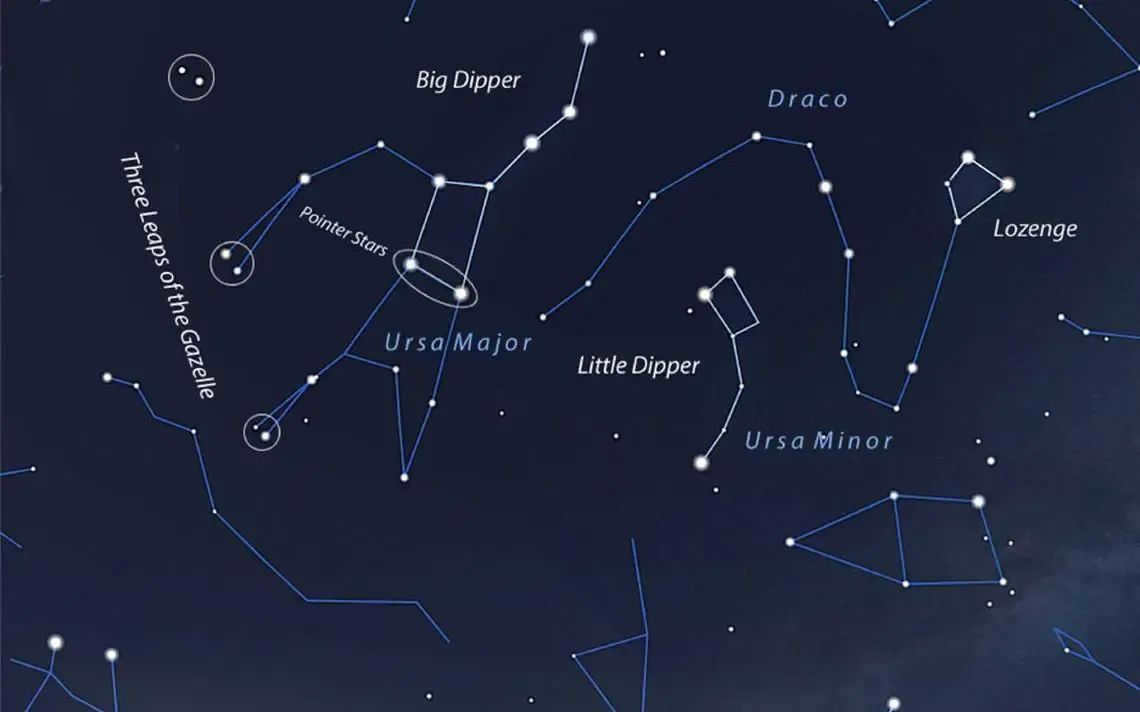
Greetings, esteemed readers of the Interessno.ru website. Throughout the ages, diverse civilizations and cultures have gazed into the nocturnal expanse to observe constellations. Many of these celestial groupings are named after gods and goddesses, while others take their designation from animals and more. Although the stars within constellations may appear close together when we view the night sky, in reality, they are separated by vast distances.
Today, we have decided to acquaint you more intimately with constellations. Within this article, we have assembled the most captivating tidbits about these celestial formations.
No. 1
The Southern Cross is the most prominent constellation in the Southern Hemisphere, while Orion takes the title in the Northern Hemisphere.
Crux, also known as the Southern Cross, holds the record for being the smallest constellation, covering just 0.165% of the night sky. On the other end of the spectrum, Hydra is the largest constellation, occupying a whopping 3.158% of the entire celestial dome (equivalent to 1,303 square degrees). This constellation got its name from the Lernaean Hydra, a mythological creature with multiple snake-like heads. However, Hydra can only be observed from specific locations on Earth. In North America, it is visible only from Alaska and Northern Canada, while in Europe, it can be seen in select Scandinavian countries like Finland and Sweden.
№2
A constellation refers to a specific area of the night sky that is demarcated by defined boundaries, encompassing all the stars and other celestial objects within those boundaries. In scientific terminology, stars that form distinct patterns within a constellation are known as asterisms. Typically, these asterisms are located within the same constellation and are named after the unique pattern they create. In addition to stars, constellations also include nebulae and galaxies.
However, it is important to note that an asterism does not qualify as a full-fledged constellation. For instance, the Big Dipper is a well-known asterism, but it represents only a portion of the larger constellation known as Ursa Major.
№3
Seasonal variations occur with most constellations, although certain ones can only be observed during specific times of the year.
For instance, in the Northern Hemisphere, Orion is visible during the winter season, Leo during spring, Scorpius during summer, and Pegasus during fall.
Additionally, there are constellations near the poles that can be seen in the sky at all times.
№4
Back in 1922, the heavens were divided into 88 constellations, a categorization that endures to this very day. Out of these, 48 were documented by the Greek astronomer Ptolemy in his renowned work Almagest, which was penned around 150 AD.
№5
Across our planet, there isn’t a single location from which all the constellations visible in the sky can be observed. That’s why star charts are split into two sections: one depicting the Southern Hemisphere and another showcasing the Northern Hemisphere.
Number 6
Similar to our Sun, stars and constellations travel from east to west. Every evening, as the sun sets, new stars and constellations emerge in the eastern part of the sky. As the night progresses, they gradually move across the sky and eventually disappear over the western horizon by dawn. The constellations that become visible in the east experience a daily shift of approximately 1 degree per day. Considering that a full revolution is 365 degrees and a year lasts 365 days, these constellations are generally in the same position on the same day each year, with a slight margin of error of around 5 degrees compared to the previous year.
№7
Every constellation possesses its own Greek mythos regarding its origin. Typically, these narratives revolve around deities and enigmatic mythological beings. They encompass figures such as King Cepheus, his spouse Cassiopeia, and their daughter Andromeda. Additionally, there are tales of Heracles, the son of Zeus and Alcmene, who defeated the Nemean lion known as Leo. Another mythological character is Perseus, the son of Zeus and Danae, who slew Medusa and caused the creation of Pegasus, the horse that came to life from the blood spilled. These are just a few examples of the captivating stories associated with the constellations.
Number 8
There are a group of constellations known as the “Zodiac”. In total, there are 13 constellations. Out of these, twelve are commonly used as signs in the zodiac calendar and astrology. These twelve constellations include:
- Capricorn.
- Aquarius.
- Pisces.
- Aries.
- Taurus.
- Gemini.
- Cancer.
- Leo.
- Virgo.
- Libra.
- Scorpio.
- Sagittarius.
- Serpentine.
№9
Throughout history, celestial bodies have served as vital markers for humanity. These celestial bodies were utilized by people to establish the optimum time for planting and harvesting crops. Interestingly, farmers were among the earliest adopters of these celestial markers in their agricultural practices. They were also employed for keeping track of the calendar. However, their most significant application was in the realm of navigation. For instance, by locating the constellation Ursa Minor, one can easily find Polaris. By using Polaris as a reference point, navigators were able to determine their direction of travel with relative ease. The key factor here is that Polaris is situated directly above the North Pole, rendering it invisible in the southern hemisphere.
№10
Awareness of stars dates back to ancient Greece. The ancient Greeks acquired knowledge of the stars, likely from the ancient Egyptians, who in turn learned about the starry sky from the Babylonians. Many consider the Babylonians to be the founders of astronomy, but this is not entirely true. The Babylonians actually gained knowledge from the Sumerians, as indicated by records from around 1000 B.C. that mention the names of Sumerian scientists.
There are also ancient rock paintings, created by humans around 17,000 years ago, that depict stars gathered in clusters.
№11
Occasionally, celestial formations are categorized into clusters or constellations. These groupings can be found in specific regions of the night sky and are typically named after the most prominent constellation within that vicinity. To illustrate, the Hercules cluster comprises 19 constellations, the Big Dipper cluster has 10, Perseus has 9, and Orion has 5.
№12
The Sun was the first star to be photographed, which is not surprising at all. The second star to be photographed was Vega. It is situated in Lyra, which, in turn, has the shape of a harp.
№13
Orion is one of the most ancient constellations known to mankind. Orion is renowned not only for its age, but also for its visibility from almost anywhere on Earth. It also contains some of the most brilliant stars that form the famous Orion Belt. That’s all for now, dear readers. Thank you for choosing our website among all the resources available on the Internet.

